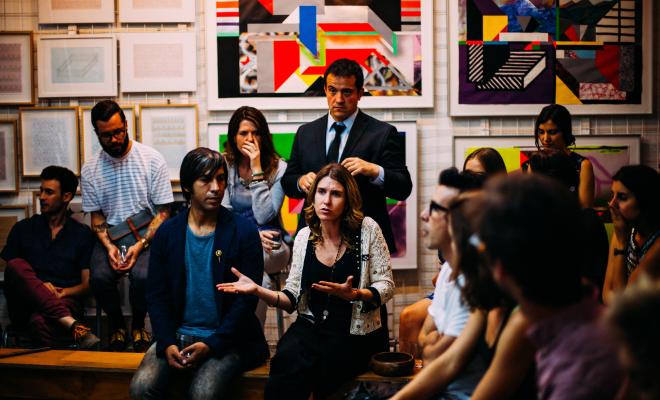03 Dec 2025
All big change in human history has always started with the grassroots.
Tabea, Cardiff Climate Action.
To tackle the climate and ecological emergency, we need more people to be actively involved with local campaigning. And to be genuinely effective, we need a movement that reflects a more diverse range of voices.
As we start to see the impacts of the climate crisis more frequently, both in the UK and abroad, more people will be looking for ways they can take action. This will be particularly true following the devastating effects of extreme weather like flooding, or in the aftermath of important global events like the UN Climate Talks, when the urgency of the crisis will be top of people’s agenda. It’s important that your group is ready to welcome these people to the movement so together we can form an unstoppable wave of action.
We can already see the impacts of climate breakdown in our towns and villages, but those impacts affect people differently. For example, air pollution will generally affect those living on busy roads the most. To be truly representative and build more powerful campaigns, we need to reach out and involve people with different experiences.
When you have a strong support base, it's easier to show local leaders that it's in their best interest to act on climate and nature issues.
Ultimately, a bigger group that spans a range of backgrounds and experiences ensure greater equity and means more campaigning impact. But not everyone is ready to dedicate spare time to a cause they've just come across. Think about how you can involve people that are short on time but show interest...
Grow your mailing list
A mailing list is a list of people who've given you consent to contact them, either via post or email. Having a mailing list means you can reach multiple people at one time with campaign updates, event invites and petitions.
Friends of the Earth Norfolk has seen first hand just how impactful a mailing list can be:
"It’s a great way of getting more people involved in our other activities. I send out newsletters with details of events we’ll be running or attending, and if there’s a campaign we’re supporting I’ll email them and ask them to get involved. For example. I recently sent out an email with a link to the DEFRA peat consultation asking people to complete it to show DEFRA how important it is to people that we end the use of peat in gardening."
There are several ways you can attract people to sign up to your mailing list.
Ask people to sign a petition. Getting signatures for a petition or campaign ask is a great way of showing community support for a cause and building your mailing list. The easiest way to set up a petition or campaign ask is on Action Network, if that's part of your campaign. If you’re not on Action Network and you’d like to be, do get in touch and we can get you set up.
Bring a sign-up sheet to events you take part in [download template]. That way you can capitalise on connections made while out in the community by ensuring people leave their names and email addresses (along with a signature for consent) to find out more.
Include a contact email address on any leaflets or press releases you put out. That way people have an easy way to ask to be added to your list, if they wish.
You'll also need to think about how you keep your mailing list engaged and encourage them to get involved in your group's activities. A monthly email newsletter with campaign updates, events and tips could be a good option to keep your group on their radar.
Invite new members via social media
It's natural for people to want a bit more information before they join a cause or become a member of an organisation. And much like a job interview, people tend to look at websites, do a quick search online and follow social media accounts before taking the next step.
With that in mind, remember to post regular updates and invites to group meetings and events on your social channels, and share photos once they've happened. Not only will posting photos help make your group look more active and human, it'll give your followers the chance to join in at a deeper level when they're ready.
For more ideas on how to use social media in your campaigning, check out our beginner's guide.
Hold events to welcome new members
You should host special events that are specifically designed for new people a couple of times a year at least, especially straight after period of active recruitment such as building your mailing list via a petition or following events that will drive people towards wanting to take action such as extreme weather events.
Some people might be completely new to local campaigning and so are more likely to come along to an initial meeting if they know they’ll have a chance to find out more about your group and meet other newcomers. It’s important that these events are fun and focused on getting to know one another rather than a traditional meeting format. For example you could host a picnic or a meet up in a local café.
Make sure you have ways that they can get active with you, ideally meaning they leave with a plan for what they will do next, having taken on some kind of responsibility. Find out what people are interested in and what expertise or experience they have to offer. You should have some tangible tasks for people to take on like helping collect signatures for a petition, sending out an email to your mailing list or joining a stall.
Remember to follow up with a 1-1 conversation using this script to confirm how they will be involved. Find out more about how to welcome new members in our guide.
More ideas to recruit group members
- Get involved in local events like street parties, local fairs etc where you can talk to people face-to-face about your group and invite them to join.
- Host "open hours" in a local café where people can drop in to chat.
- Work with your local schools: plan an event together, discuss ways to reduce the school’s carbon footprint, engage the parents’ associations
- Get in touch with your local university: hold a talk, invite an MP, engage with the students and encourage them to sign up to the mailing list. Post "volunteer ads" for specific skills in the university’s online forums.
- Plan moments when there’s more attention around climate.
- Build partnerships with other local community groups and organisations. Collaborating with others can be mutually beneficial and make our campaigns stronger and more impactful. This beyond groups that you know well. Try reaching out to faith groups, trade unions or housing action groups for example. This guide on building local alliances can give you a helping hand to get started.
Clear messaging
It may sound obvious, but you're more likely to attract interest in your group if you make key bits of information clear, like your aim and purpose. Consider the following points when you're actively recruiting new members:
- Your audience. Does your audience know who you are and why action is needed? Is there a local issue that has attracted a lot of attention? Adapt your message to appeal to people's interests.
- Your group. If you have a regular meeting spot or time you meet, make sure to include that information on your post or invite.
- Your channel. Think about the changes you made need to your messaging depending on the channel (shortening text, including hashtags or hyperlinks, appropriate imagery etc).
- Your focus. Stick to a key focus. If you want more people to join because you're involved in a specific campaign, focus the content around that campaign. If it's a more general recruitment drive, appeal to the benefits of joining your group (for example, making change in the community, joining like-minded people, exercising democratic rights etc). Keep it simple and focused. Your key message can then be adapted to fit the channel / audience.
- Factcheck and proofread!




